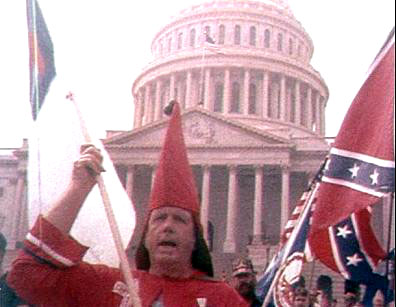|
● Why
Did the Social Movements Begin?
● Who
Worked in the Social Movements?
● What
Is a Social Movement?
● The
Civil Rights Movement
● Organizations
● Direct Action Tactics
● Changes
● The Youth Movement
/Anti-War Movement
● The Women's Movement
● Conclusion
Organizations
 One
reason that the sit-ins in Greensboro were successful was that black
students had formed a new organization, the Student
Nonviolent Coordinating Committee (SNCC). SNCC was the
third main organization in the civil rights movement, the others
being the Congress
of Racial Equality (CORE), the Southern
Christian Leadership Conference (SCLC). These three groups
provided the leadership, the nonviolent tactics, the network and
the people to fight against Southern segregation. . CORE was founded
by James Farmer and others who used nonviolent direct action to
integrate restaurants in Chicago in the 1940s. In
1947, CORE members, Negro and white, joined other groups in a nonviolent
"freedom ride"
to integrate buses and bus stations in the South. Freedom
rides became an integration strategy in the 1960s. The strongest
leadership came from the SCLC, headed by Baptist minister Martin
Luther King, Jr. This regional group, One
reason that the sit-ins in Greensboro were successful was that black
students had formed a new organization, the Student
Nonviolent Coordinating Committee (SNCC). SNCC was the
third main organization in the civil rights movement, the others
being the Congress
of Racial Equality (CORE), the Southern
Christian Leadership Conference (SCLC). These three groups
provided the leadership, the nonviolent tactics, the network and
the people to fight against Southern segregation. . CORE was founded
by James Farmer and others who used nonviolent direct action to
integrate restaurants in Chicago in the 1940s. In
1947, CORE members, Negro and white, joined other groups in a nonviolent
"freedom ride"
to integrate buses and bus stations in the South. Freedom
rides became an integration strategy in the 1960s. The strongest
leadership came from the SCLC, headed by Baptist minister Martin
Luther King, Jr. This regional group,
 |
|
The
Ku Klux Klan
|
organized in 1957 to link Southern Negro
churches in the work for civil rights, was begun by church ministers
who were the moral and cultural leaders of Negro communities. Ministers,
who met regularly in regional meetings, worked together across state
lines. It was convenient for the ministers to pass information to
their members and organize activities because church members met
weekly for meetings of church organizations and for church services.
 SNCC
was founded by a group of students who wanted to end all forms of
racial domination. Ella Baker, SCLC executive director, helped the
students organize. SNCC, unlike SCLC, had a collective leadership
which followed the principle, "Let the people decide."
SNCC taught their members to be nonviolent when they protested segregation
laws in Southern states, even when they were beaten and arrested.
SNCC moved quickly from being just a "coordinating committee"
to organizing direct action in the deep South. At the beginning
of the movement, the base of their membership was the large number
of black students in the South. SNCC
was founded by a group of students who wanted to end all forms of
racial domination. Ella Baker, SCLC executive director, helped the
students organize. SNCC, unlike SCLC, had a collective leadership
which followed the principle, "Let the people decide."
SNCC taught their members to be nonviolent when they protested segregation
laws in Southern states, even when they were beaten and arrested.
SNCC moved quickly from being just a "coordinating committee"
to organizing direct action in the deep South. At the beginning
of the movement, the base of their membership was the large number
of black students in the South.
Previous Page Next
Page
|

